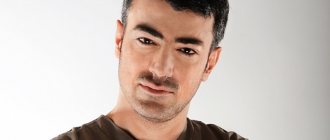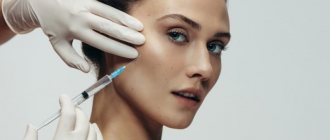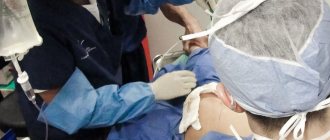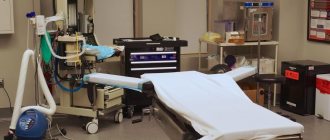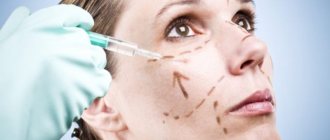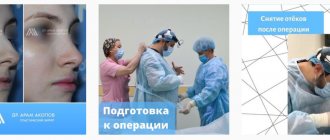Rhinoplasty is the surgical correction of congenital or acquired defects in the shape of the nose. A whole trend in plastic surgery and one of the most popular aesthetic procedures after liposuction and breast augmentation - 30% of all patients who apply dream of having a beautiful nose.
Rhinoplasty is a complex aesthetic surgery on the face. Vladimir Aleksandrovich Kosinets held the position of leading employee of the Department of Plastic and Reconstructive Surgery at the Federal State Budgetary Institution Scientific Center of Otorhinolaryngology of the Federal Medical and Biological Agency of Russia; the acquired skills and experience help to achieve results in changing appearance without visible incisions
RHINOPLASTY - TYPES OF OPERATION
Plastic surgery of the tip of the nose. Corrects hookiness and excessive upturning. During nasal tip plastic surgery, it is also possible to correct a protruding, bifurcated, or too retracted columella - a skin fold of the nasal septum.
Septoplasty. Eliminates deviated nasal septum. As a result: it relieves snoring and problems with nasal breathing.
Plastic surgery of the base of the nose. Aimed at reducing the width of the nostrils.
Plastic surgery of the back of the nose. Eliminates hump and corrects saddle nose.
Indications
Indications for this type of intervention can be divided into medical and aesthetic. Medical ones include:
- congenital or acquired pathology of the shape of the nose;
- traumatic damage to the nose, loss of part of the tissue;
- nasal breathing disorders and a number of others.
Rhinoplasty in Minsk for aesthetic reasons accounts for about 60% of all operations at the Edaran-Medical Center:
- excessive or insufficient size of the nose or its parts (too large or small nostrils, etc.);
- asymmetrical nose;
- disharmonious size of the nose relative to other facial features (for example, a too long nose or an overly pronounced hump).
YOU CAN FIND OUT WHAT THE RESULT OF RHINOPLASTY WILL BE DIRECTLY AT YOUR CONSULTATION
In order for the results of rhinoplasty to be as effective as possible, interaction between the patient and the surgeon is important. Try to describe the desired result during the preliminary consultation. The doctor will digitally simulate the possible result of the operation, taking into account the anatomical parameters of your nose.
In aesthetic surgery there is no concept of an “ideal nose”, since the parameters of each person’s face are absolutely individual and unique. There is no point in wanting a nose like Angelina Jolie's for the simple reason that it may simply not “fit” into the proportions of your face.
Reviews
KRISTINA, 41 YEARS OLD:
“After reading reviews online, I learned a lot of information about the best plastic surgeons in Minsk, and decided to fulfill my old dream with the help of Viktor Vasilyevich Baryash.
I had blepharoplasty and spacelifting done with him, and I was very pleased with the results. Now I look 15 years younger, everyone noticed.”
IGOR, 27 YEARS OLD:
“Since childhood, I was dissatisfied with my own nose, I was teased at school, I was ashamed of myself.
I would like to say a huge thank you to Dr. Yatskevich for his excellent work, detailed consultations and patience. My wishes were fully taken into account, I recommend!”
We hope that our rating of the best plastic surgeons in Minsk will help you make the right choice.
Before making a decision, be sure to read reviews about the doctor, inquire about his merits, and do not hesitate to ask him questions. A good doctor will definitely tell you about everything that interests the patient.
PREPARATION FOR RHINOPLASTY
Even if you have a minor nose correction, it is still a surgical intervention, and you need to take the preoperative recommendations seriously:
- Stop smoking and drinking alcohol. These habits shorten life and prolong the healing process of wounds. Some surgeons do not even undertake to operate on smokers with many years of experience!
- On the eve of the correction, you should not carry out cosmetic procedures such as medium or deep chemical or laser peeling.
- Ultraviolet radiation reduces the functions of the immune system - minimize your exposure to the open sun.
You can find out more about how to prepare for surgery and what tests you need to take in our recommendations.
The most popular operations in Belarus
Today, visitors to aesthetic medicine clinics do not at all want to look like a Barbie doll.
In most cases, patients' wishes are simpler: changing the size of the ears, the shape of the nose, or breast correction.
According to experts, the ranking of the most popular operations includes:
- Blepharoplasty . Changing the shape of the eyelids allows you to eliminate wrinkles and hernias. Simple manipulations give excellent results, the patient becomes 5 to 7 years younger.
- Rhinoplasty . Correction of the shape and size of the nose, elimination of the hump, straightening of the deviated nasal septum.
- Otoplasty. Elimination of protruding ears, reduction in size and change in the shape of the ears are indicated even for children from 8 years of age. This is explained by numerous complexes and psychological discomfort from which the child suffers every day.
- Rhytidoplasty. Thanks to a circular facelift, it is possible to solve several problems at the same time: smooth out wrinkles, nasolabial folds, eliminate sagging skin, and restore clarity to contours. The procedure is in demand among women and men after 45–50 years.
- Liposuction. According to thematic forums, we can conclude that many people turn to the best plastic surgeons in Belarus for liposuction. The operation involves removing fat deposits from problem areas: the abdomen, hips, arms, thighs and other areas.
- Abdominoplasty. This is correction of the abdominal wall, elimination of stretch marks.
- Mammoplasty. And another popular operation is breast reshaping. The range of services of Belarusian plastic surgeons includes breast lift and breast reduction. The most popular type of breast augmentation is the installation of high-quality implants.
Most aesthetic medicine clinics in the country are represented by government agencies, so prices are democratic.
Various segments of the population become patients of surgeons: from business women to retirees.
Many operations are available to average Belarusians, people with average earnings.
The majority of patients are women, but the number of males is increasing every year.
Previously, men were interested in correcting their ears and noses, but today the requests have changed somewhat, more often they do a circular facelift and blepharoplasty.
Many people have realized that appearance is of great importance these days, as it is an indicator of health and attentive attitude towards oneself.
HOW THE OPERATION WORKS. CLOSED AND OPEN RHINOPLASTY
Rhinoplasty can be performed under general anesthesia or local anesthesia. Can last from 30 minutes to 1.5 hours.
Where might the cuts be?
Currently, there are two types of access when performing rhinoplasty - open and closed.
- Open rhinoplasty is the most traumatic type of intervention. Suitable for large volumes of work. The surgeon makes an incision in the columella, the vertical fold of skin that separates the nostrils. A triangle-shaped flap of skin is folded toward the bridge of the nose to access the nasal bones and cartilage. The advantage of the method is the most accurate correction of defects, the disadvantage is visible scars.
- Closed rhinoplasty is less traumatic. Using this method, you can change the shape, correct the tip of the nose, or remove a hump. The incision is made in the nasal cavity and remains invisible. The advantages of the method are the absence of external scars and a short recovery period, the disadvantage is that it is technically more difficult.
Today, less traumatic closed rhinoplasty is increasingly preferred. The final result of the operation can be assessed after 6-8 months, since the healing of cartilage and bone tissue is longer than that of soft tissue.
Nose job - rhinoplasty
- Description
- Preparing for surgery
- How is the operation performed?
- After operation
- Complications
- Questions and answers
Description
An operation to correct an unattractive nose shape or to eliminate deviated internal septums is called rhinoplasty.
.
Aesthetic rhinoplasty includes two types of operations. soft tissues
only .
This is the simplest intervention that allows you to raise or narrow the tip of the nose, change the shape of the nostrils, and correct the skin septum between the nostrils. The second type of operation is more complex, since it is necessary to change bone and cartilage tissue
.
This way the nasal hump is eliminated. As for rhinoplasty for medical reasons
, the result is that the curvatures inside the nose are corrected and the airways are cleared. Such operations are indicated mainly after injuries and in cases of congenital and acquired defects.
Equipment, as well as the qualifications and experience of surgeons at our Medrekplast Center for Plastic Surgery and Cosmetology in Minsk
allows you to perform any
plastic surgery of the nose
.
Contraindications:
- diseases that are accompanied by reduced blood clotting
; - hypertension
, severe
cardiovascular diseases
; - diabetes mellitus
and severe
thyroid
; - acute and chronic infectious
diseases, including skin diseases; - collagenoses
; - pregnancy
; - days of menstruation
Rhinoplasty is allowed only from the age of
, because at this age the formation of nasal cartilage ends.
Sometimes, in exceptional cases, this operation is also performed on children
, when the curvature of the nasal septum is so serious that the physical and behavioral development of the child suffers due to difficulty breathing.
Photos of patients before and after surgery to correct the shape of the nose
which were carried out at our
Center for Plastic Surgery and Cosmetology “Medrekplast” in Minsk:
Preparing for surgery
Before the operation you must:
- be examined by an otolaryngologist
(he may prescribe an x-ray of the sinuses or an endoscopic examination) - complete all prescribed examinations and tests
- talk to an anesthesiologist
- Tell your surgeon and anesthesiologist about all medications you are taking
- ask someone to drive you home after surgery
- During a consultation with a plastic surgeon, it is advisable to conduct a computer modeling
of the future shape of the nose to avoid misunderstandings in its assessment on both sides
Two weeks before surgery you cannot:
- smoke
- drinking alcohol
- sunbathe, as ultraviolet radiation suppresses the immune system
- take medications that reduce blood clotting
, including aspirin
On the day of surgery:
- Three to four hours before surgery, large meals and liquids are prohibited. But this issue should be discussed with the anesthesiologist, as this directly affects the safety of pain relief.
- Do not apply creams or make-up
. It is advisable to strive for the absence of skin irritation.
How is the operation performed?
You come with ready-made tests. The administrator draws up a medical history. You fill out the necessary documents and sign consent for the operation. The administrator escorts you to the room, where you change into disposable underwear, which is required in order to enter the operating room. Then you go to the surgeon and clarify all the details with him.
This is followed by an examination by the surgeon and anesthesiologist, after which a decision is made on the possibility of performing the operation at the moment. A photo of your face is usually taken
in several projections.
Operation
carried out in two ways:
- Closed method
, when an incision is made inside the nasal cavity, then the soft tissue is peeled off from the osteochondral frame and then the necessary corrective manipulations are performed. This method is less traumatic, the scars will not be visible, it is most often used to correct aesthetic problems. - The open method
is used for technically complex operations. In this case, the incisions pass through the visible part of the skin, and, as a result, visible post-operative scars remain.
The operation is performed in a hospital setting and lasts 1-2 hours, sometimes 3 or more. Use appropriate types of general anesthesia.
After operation
After the operation, you will be taken to the recovery room, where you will remain for 24 hours under the supervision of a doctor.
. After the operation, a bandage and a plaster splint are applied, which is removed after 1-1.5 weeks.
Possible after surgery
a rise in body temperature to 37.5°C, swelling of the face, especially around the nose and eyes, numbness and tingling of the skin, which
is normal and gradually disappears
.
To speed up recovery, physiotherapeutic procedures
. The rehabilitation period lasts 3 weeks, and the final assessment can be carried out only after six months to a year.
What to do after surgery:
- For the first three days , apply cold
to the operated areas to stop bleeding and reduce swelling. - During sleep, the position of the head
should be higher than the position of the chest for several days. - To prevent infectious inflammation, take prescribed antibiotics for 5 days
. - It is advisable not to take spicy food or excess liquid
until swelling and inflammation subside. - For 3 months, visiting the bathhouse and sauna
, as well as any thermal procedures, is prohibited. You cannot sunbathe; you must cover your face with an umbrella or hat in the sun. - Don't wear glasses
for a month . - Avoid smoking and large doses of alcohol
. - Do not wash with hot water
for two weeks , avoid bending over and
heavy physical and emotional stress
. - If necessary, visit your doctor in a few days for a follow-up examination
. - For several days, do not take
aspirin, ibuprofen, or other medications or herbal supplements that may increase bleeding. If necessary, use acetaminophen (Tylenol, etc.) to control pain.
Contact your doctor immediately if you experience any
of the following conditions:
- Dyspnea
- Chest pain
- Unusual heartbeat
- Bleeding
Complications
Possible complications of rhinoplasty:
Rhinoplasty is considered one of the most complex plastic surgeries, the outcome of which largely depends on the skill and experience of the surgeon. Complications occur in 4-15% of cases. They can occur during surgery (bleeding, skin tears, separation of a mucocartilaginous flap, violation of the integrity of the bone pyramid, fracture of a bone area, etc.) and postoperatively.
- functional - atrophic rhinitis, difficulty in nasal breathing, loss of smell, temporary or permanent decrease or complete loss of skin sensitivity of the nose and upper lip;
- aesthetic - no change or worsening of previous deficiencies;
- psychological - patient dissatisfaction with the results of plastic surgery;
- infectious - prolonged swelling and inflammation, suppuration;
- pigmentation of the skin of the nose, the formation of a vascular network, adhesions of the mucous membrane and rough scars;
- recurrent nosebleeds and necrosis of soft tissue or cartilage.
All these complications directly depend on the skill of the doctor, so choosing an experienced plastic surgeon with the appropriate qualifications
, You will reduce this probability to a minimum.
These are the specialists who work in our Center for Plastic Surgery and Cosmetology “Medrekplast” in Minsk
, who will perform the operation at the highest professional level.
Questions and answers
Why is rhinoplasty needed?
— With this operation, the shape of the nose is improved by manipulating its bones and cartilage. Depending on your desire, the nose can be made smaller, smoother, and straighter. Both removal and replanting of tissue are used. Today, they try not to remove a lot of tissue, as this sometimes leads to respiratory dysfunction. Instead, a competent surgeon develops an individual treatment plan for each area.
How is the operation performed?
— The duration of the operation is 1-3 hours. General anesthesia is usually used, although sometimes patients insist on using local anesthesia. Some surgeries can be performed on an outpatient basis.
Where are the incisions located during rhinoplasty?
— Most often, the surgeon makes incisions inside the nostrils. Sometimes, to narrow the nose, incisions may be used where the skin of the nose meets the skin of the cheek. But incisions at the tip of the nose or bridge of the nose are practically not used.
How long do temporary side effects last?
— It depends on the complexity of the operation. Within a week, most patients will experience discoloration of the skin, and there may also be swelling around the top of the cheeks and around the eyes. The nose also remains swollen for 10-16 days. In rare cases, swelling finally goes away only after a few months.
Is it possible to perform plastic surgery for a deviated nasal septum at the same time as rhinoplasty?
- It's always possible. And sometimes it is simply necessary to achieve the planned result.
FEATURES OF REHABILITATION AFTER RHINOPLASTY
The rehabilitation period after nose surgery is quite long. Conventionally, it can be divided into 4 periods:
- First week. The most difficult time for the patient, since the plaster or silicone splint and turundas inside make breathing difficult. There may be bruising and swelling.
- Second week. The plaster is removed. The patient can breathe much more freely. You cannot lift weights, drink alcohol, sunbathe, or play sports. You can only sleep on your back.
- The third week is three months. Time for cosmetic restoration. The patient returns to his normal lifestyle. The swelling gradually goes away, and the nose is getting closer to its ideal condition.
- Up to six months. Full recovery.
Despite the described moments that complicate the patient’s life during the rehabilitation period, rhinoplasty is one of the most painless procedures.
Postoperative period
The postoperative period takes place in several stages:
- primary: awakening after anesthesia. As a rule, hospitalization is not required during the operation; the patient takes painkillers and sedatives to eliminate discomfort;
- secondary: up to 10-12 days, wearing a plaster or plastic splint, limiting physical activity;
- final: up to two and a half to three weeks, complete disappearance of hematomas and edema; restrictions on visiting the solarium, bathhouse, sauna, swimming pool and gym.
CONTRAINDICATIONS
- Age up to 18 years
- Diabetes
- Immunodeficiency conditions
- Chronic diseases in the acute stage
- Menstrual cycle
PRICES FOR NOSE PLASTY
| NAME | Price, white rubles |
| Rhinoplasty (nose reduction) | 5000 |
| Rhinoseptoplasty | 7000 |
| Rhinoplasty (nose tip) | 4000 |
| Rhinoplasty (back) | 4000 |
| Rhinoplasty (nose wings) | 3000 |
Vladimir Aleksandrovich Kosinets conducts consultations in Minsk and Vitebsk. You can make an appointment by phone +375 25 902 19 44.
Result
The primary result is visible a month after the operation, when the swelling subsides and the hematomas disappear.
The result of the correction can be assessed after three months, when tissue blood circulation is completely restored.
For the operation it is necessary to undergo a number of tests:
- Complete blood count + platelets + coagulation (valid for 10 days)
- Blood type, Rh factor
- Coagulogram (valid for 10 days)
- General urine test (valid for 10 days)
- RW blood test (valid for 1 month)
- HIV test (valid for 1 month)
- Fluorography (valid for 12 months)
- Blood test for hepatitis B, C (valid for 1 month)
- Biochemical blood test (total protein, sodium, potassium, calcium, chlorine, cholesterol, urea, creatinine, glucose, total bilirubin, direct bilirubin, AST, ALT, chlorides) (valid for 10 days)
- ECG with interpretation (cardiologist's report if necessary) (valid for 1 month)
- X-ray of the paranasal sinuses
- Physician's report for persons over 50 years of age (valid for 14 days)
- In the presence of chronic diseases - an extract from the outpatient card with a physician’s conclusion (valid for 14 days)
